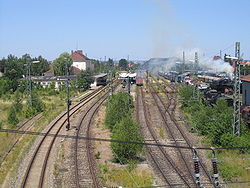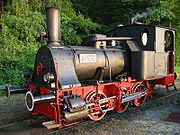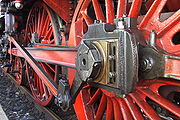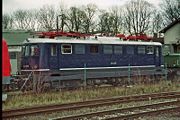
Bavarian Railway Museum
Encyclopedia




Bavaria
Bavaria, formally the Free State of Bavaria is a state of Germany, located in the southeast of Germany. With an area of , it is the largest state by area, forming almost 20% of the total land area of Germany...
, Germany
Germany
Germany , officially the Federal Republic of Germany , is a federal parliamentary republic in Europe. The country consists of 16 states while the capital and largest city is Berlin. Germany covers an area of 357,021 km2 and has a largely temperate seasonal climate...
. It is home to more than 100 original railway vehicles and has been located in the depot (Bahnbetriebswerk or Bw) at Nördlingen
Nördlingen
Nördlingen is a town in the Donau-Ries district, in Bavaria, Germany, with a population of 20,000. It is located in the middle of a complex meteorite crater, called the Nördlinger Ries. The town was also the place of two battles during the Thirty Years' War...
since 1985.
History of the locomotive shed
The shed, itself, has a long history. As early as 1849, with the construction of the Ludwig South-North RailwayLudwig South-North Railway
The Ludwig South-North railway , built between 1843 and 1854, was the first railway line to be constructed by Royal Bavarian State Railways...
from Lindau to Hof
Hof, Germany
Hof is a city located on the banks of the Saale in the northeastern corner of the German state of Bavaria, in the Franconia region, at the Czech border and the forested Fichtelgebirge and Frankenwald upland regions....
, a workshop appeared for the maintenance of steam locomotives and wagons. Wings 2 and 3 of the roundhouse
Roundhouse
A roundhouse is a building used by railroads for servicing locomotives. Roundhouses are large, circular or semicircular structures that were traditionally located surrounding or adjacent to turntables...
date from this time; since then they have just been extended. The workshop building, too, dates from the 1800s, as well as the floor plan of the first recorded engine shed
Motive power depot
Motive power depot, usually abbreviated to MPD, is a name given to places where locomotives are stored when not being used, and also repaired and maintained. They were originally known as "running sheds", "engine sheds", or, for short, just sheds. Facilities are provided for refuelling and...
. The facility was regularly expanded and its use adapted in the course of time up to 1937. The last expansion was carried out from 1935 to 1937, when the locomotive shed was lengthened and a 20 metre turntable installed.
A major event in its history were the air attacks during the Second World War in 1944 and 1945, when large parts of the shed were destroyed. Only wings 2 and 3 of the roundhouse were spared, as well as the workshop building and the water tower. The facility was rebuilt and in places modernised in the years up to 1949.
For a short period the locomotive shed experienced new life as it was allocated V 100
DB Class V 100
These DB Class V 100 diesel locomotives were produced in the late 1950s by the Deutsche Bundesbahn for non-electrified branch lines as a replacement for steam locomotives...
diesel locomotives, VT 98 railbuses
Railcar
A railcar, in British English and Australian English, is a self-propelled railway vehicle designed to transport passengers. The term "railcar" is usually used in reference to a train consisting of a single coach , with a driver's cab at one or both ends. Some railways, e.g., the Great Western...
and ETA 150
DB Class ETA 150
The accumulator cars of Class ETA 150 were German railbuses used extensively by the Deutsche Bundesbahn over 40 years. The driving cars were very comfortable to travel in because they were quiet , rode well on the rails due to the weight of the batteries and were pollution-free...
accumulator cars. By 1966 the routine stabling of steam locomotives had ended. With the electrification of the Ries Railway (Riesbahn), Donauwörth
Donauwörth
Donauwörth is a city in the German State of Bavaria , in the region of Swabia . It is said to have been founded by two fisherman where the Danube and Wörnitz rivers meet...
–Aalen
Aalen
Aalen is a city in the German state of Baden-Württemberg, about east of Stuttgart and north of Ulm. It is the seat of the Ostalbkreis district, and its largest city, as well as the largest city within the Ostwürttemberg region. In spatial planning, Aalen is designated a Mittelzentrum...
, and the Danube Valley Railway
Danube Valley Railway (Bavaria)
The Danube Valley Railway in Bavaria in southern Germany is the railway line that runs from Regensburg via Ingolstadt and Donauwörth to Ulm, just over the Bavarian border in Baden-Württemberg....
(Donautalbahn), Neuoffingen–Ingolstadt
Ingolstadt
Ingolstadt is a city in the Free State of Bavaria, in the Federal Republic of Germany. It is located along the banks of the Danube River, in the center of Bavaria. As at 31 March 2011, Ingolstadt had 125.407 residents...
many of the diesel engines were dispensable, so that in 1982 the locomotive shed was closed as an independent facility. The closure of the branch lines radiating from Nördlingen did one more thing to return peace to the entire station at Nördlingen. In 1985 the railway maintenance division was moved out and operations as a satellite of Augsburg locomotive shed were ceased.
Establishment of the museum
In autumn 1985 the Bavarian Railway Museum took over the partially dismantled facilities. Since then, the museum has painstakingly attempted to equip it as a complete locomotive shed again. Several tracks had to be relaid and all the locomotive shed roads connected to the turntable. In addition two water cranes were re-installed. In the near future a coaling facility should also be brought into operation.Current museum railway operations
The Bavarian Railway Museum works the route to GunzenhausenNördlingen–Gunzenhausen railway
The Nördlingen-Gunzenhausen railway is located in northern Swabia and western Middle Franconia. The 40 km route is now a heritage railway, operated with a passenger train that is known as the Lakeland Express after the Franconian Lake District...
and the section from Nördlingen to Feuchtwangen
Feuchtwangen
Feuchtwangen is a city in Ansbach district in the administrative region of Middle Franconia in Bavaria, Germany.-Geography:Geographically and geologically the land around Feuchtwangen comprises the eastern part of the Swabian-Franconian Escarpment Land , also sometimes called the gypsum-keuper...
on the line to Dombühl
Dombühl
Dombühl is a municipality in the district of Ansbach in Bavaria in Germany....
with historical vehicles. Its daughter company, BayernBahn Betriebsgesellschaft mbH, is responsible for the maintenance of the line to Dombühl rented from the Deutsche Bahn
Deutsche Bahn
Deutsche Bahn AG is the German national railway company, a private joint stock company . Headquartered in Berlin, it came into existence in 1994 as the successor to the former state railways of Germany, the Deutsche Bundesbahn of West Germany and the Deutsche Reichsbahn of East Germany...
as well as the operation of museum vehicles on special trains, but also for other services, for example in maintenance of way trains. In addition, for several years impressive goods trains have been hauled in the Nördlingen area e.g. for wood and timber products. For this Class V 100 und V 60
DB Class V 60
The DB Class V 60 is a German diesel locomotive operated by the Deutsche Bundesbahn and later, the Deutsche Bahn AG , which is used particularly for shunting duties, but also for hauling light goods trains. Seventeen locomotives were bought used by the Norwegian State Railways and designated NSB...
diesel locomotives are usually used, but sometimes the museum's steam engines are engaged as well.
External links
- Website of the Bavarian Railway Museum
- BayernBahn Railway Company
- There is an English-language discussion forum at Railways of Germany

